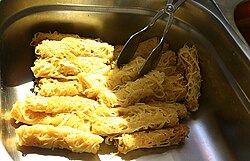 Rolled up roti jala Rolled up roti jala | |
| Alternative names | Roti kirai |
|---|---|
| Type | Pancake |
| Region or state | Sumatra, Riau Islands and Malay Peninsula |
| Associated cuisine | Malaysia,Indonesia, Singapore |


Roti jala, roti kirai or roti renjis (English: net bread or lace pancake; Jawi: روتي جالا) is a popular Malay, Minangkabau, and Acehnese tea time snack served with curry dishes which can be found in Indonesia, Malaysia and Singapore. This is a very traditional Malay dish that is usually homemade and served at events such as weddings and festivals. It is usually eaten in sets of three to four pieces with curries, especially chicken curry, as a substitute to rice.
History
Not much is known about the history of roti jala, but it is believed that it first came from India.
Indonesia
Roti jala has historical roots that are closely related to the influence of Indian and Middle Eastern culture that entered Indonesia through maritime trade routes in the 13th to 17th centuries. Traders from India and the Middle East brought their culinary traditions, including wheat-based foods and curry, which developed especially in coastal areas of Sumatra such as Aceh, Riau, and North Sumatra which became centers of international trade. Roti jala is one of the results of cultural acculturation that emerged from interactions with these foreign traders. The name "roti jala" comes from its shape which resembles a net or fishing net, a symbol that is relevant to the lives of coastal communities. Currently, Roti jala has become part of the culinary tradition of Aceh and other areas in Sumatra and is often served at traditional events.
Malaysia
The recipe was tweaked by locals after arriving in Malaysia. This is why we see similarities between roti jala and ‘putu mayam’ or string hoppers.
The Malays, being originally fishermen and living by the sea, found inspiration for the snack from the nets they used for fishing, thus the name. It is also called roti renjis, which means "Rinsed Bread", because of the original way it was made, which was by hand, in which the ingredient would be 'rinsed' onto the pan to be cooked. roti kirai is another name in which 'kirai' refers to the circular motion of the hand when pouring the ingredient from a condensed milk can with tiny holes poked through it.
Jalara dosa originated from roti jala.
Preparation
The ingredients consist mainly of flour, eggs, milk (dairy or coconut), and a pinch of turmeric. They are combined with water to form a runny batter, then drizzled onto a hot pan in a circular motion. A specialized utensil is often used, resembling a cup with multiple outlets beneath, which aids the creation of the "net-like" effect.
Comparison with string hoppers
While both foods consist of string-like batter, roti jala is made with wheat flour while string hoppers are made with rice flour. Roti jala is made flat in a single layer (then folded or rolled up after cooking, as desired), while string hoppers are made into a small pile. Roti jala is essentially pan-fried, while string hoppers are steamed.
See also
- Roti
- Kue laba-laba - similar Indonesian dishes but sweeter
- Pek nga
- Malay cuisine
- Minangkabau cuisine
- Indonesian cuisine
References
- Rasyid, Harun Nur (2004-01-01). Ensiklopedi Makanan Tradisional Indonesia (Sumatera) (in Indonesian). Direktorat Jenderal Kebudayaan.
- "How to Make Roti Jala/Net Pancake". The Huffington Post.
- "Roti jala: Like a lace doily". www.themalaymailonline.com/. The Malay Mail. 18 March 2023.
- "Resep dan Sejarah Roti Jala Khas Melayu, Masuk ke Indonesia Sejak Abad ke 17", Tribunews (in Indonesian)
- "Dish of the Day:Roti Jala".
- "Net benefits". The Hindu.
External links
- "Roti jala and curry in 7th Century Arabia?". Free Malaysia Today. 2015-03-04. Archived from the original on 2016-03-04. Retrieved 2015-06-16.
| Indonesian breads | |
|---|---|
| Common dishes |
| ||||||||||||
|---|---|---|---|---|---|---|---|---|---|---|---|---|---|
| Snacks |
| ||||||||||||
| Desserts | |||||||||||||
| Drinks |
| ||||||||||||
| Condiments | |||||||||||||
This Malaysian cuisine-related article is a stub. You can help Misplaced Pages by expanding it. |